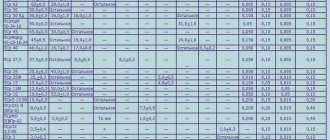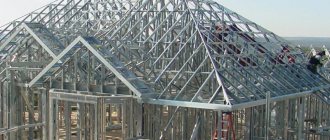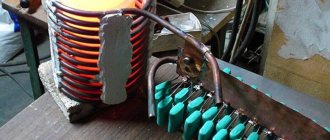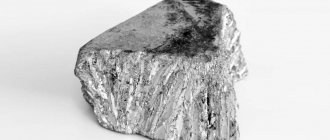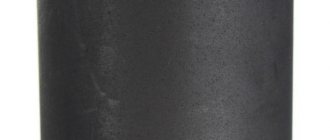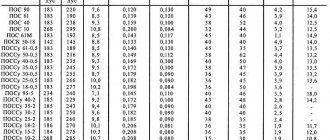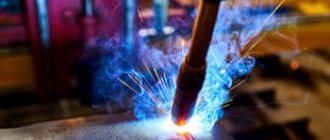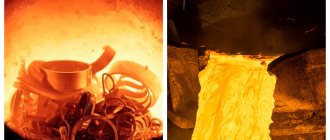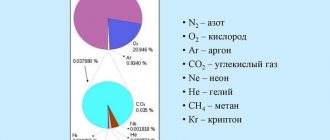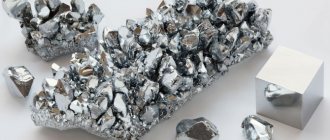Visual determination of the temperature of heated metal
Heat treatment of steel parts is carried out in cases where it is necessary either to increase the strength, hardness, wear resistance or elasticity of a part or tool, or, conversely, to make the metal softer and easier to machine.
Depending on the heating temperature and the method of subsequent cooling, the following types of heat treatment are distinguished: hardening, tempering and annealing.
In amateur practice, you can use the table below to determine the temperature of a hot part by color.
| Heat color of steel | Heating temperature, °C |
| Dark brown (visible in the dark) Brown red Dark red Dark cherry red Cherry red Light cherry red Light red Orange Dark yellow Light yellow Bright yellow | 530-580 580-650 650-730 730-770 770-800 800-830 830-900 900-1050 1050-1150 1150-1250 1250-1350 |
Alloy types
Depending on the intensity of heating required for the transition of a metal from one state to another, alloys are divided into several types.
Low fusible. They can be processed even without special equipment. The melting point of steel in degrees Celsius is 600. Low-melting metals include lead, tin and zinc.
Mercury deserves special attention because it can turn into a liquid state at -39°C.
Medium melting. The melting point of steel is in the range of 600°C-1600°C. This category includes aluminum, copper, tin, some types of stainless steel and various alloys with a small chromium content. Medium-melting compounds are most widespread in industry and in everyday life.
Refractory. Compounds included in this category are capable of transitioning from solid to liquid when heated above 1600°C. These are highly alloyed metals, which include tungsten, titanium and chromium. Thanks to these additives, the metal acquires increased strength, resistance to corrosion and chemical influences. In particular, stainless steel is a refractory alloy.
Alkali metals melt at the lowest temperatures. Accordingly, for non-alkali metals to transition into the liquid state, the temperature range increases significantly.
Boiling degree
When heating a material, it is important not to reach its boiling point, at which point it goes from a liquid state to a gaseous state. Therefore, the boiling point is an equally important technological indicator.
The boiling point is typically twice the degree at which materials melt and is determined at normal atmospheric pressure. As the pressure increases, the heating intensity also increases. As the pressure decreases, the readings decrease.
Features of Carbon Steel
Carbon compounds are the main type of products produced at metallurgical plants. In addition to iron, they also contain carbon. Its concentration should not exceed 2.14%. They contain a small amount of impurities and alloying components in the form of manganese, silicon and magnesium. Such additives can improve their physical and chemical properties.
Depending on the carbon concentration, carbon compounds are divided into the following types:
- low-carbon (carbon content does not exceed 0.29%);
- medium carbon (up to 0.6%);
- high carbon (more than 0.6%).
Carbon compounds are used in various industrial sectors. Depending on the scope of application, alloying components are added to them to achieve specific properties, including heat resistance, corrosion resistance, etc. According to these criteria, they are divided into the following categories:
Manganese is added to tool tools, which significantly improves the quality of the metal. The melting point of carbon steel is 1535°C.
Features of Alloy Steel
Additional components are introduced into the composition of alloyed compounds. In certain quantities they give them the required properties. Depending on the concentration of such elements, they are divided into the following types:
- low-alloyed (with a concentration of 2.5%);
- medium alloyed (up to 10%);
- highly alloyed (over 10%).
By adding additional components, it is possible to increase strength, corrosion resistance and improve other characteristics. The alloying components are chromium, copper, nickel, nitrogen, vanadium, etc. The melting point of alloy steel ranges from 1400°C to 1480°C.
Features of stainless steel
Stainless steel is an alloy that is resistant to dry and wet corrosion and is immune to aggressive substances. To give it the necessary properties, various alloying components are added to the metal in the form of chromium, nickel, magnesium, titanium, etc. The melting point of stainless steel in Celsius is 1350-1500 degrees.
Below is a table showing the melting point of heat-resistant stainless steel of the most popular brands.
| Brand | t°С |
| 12Х18Г9 | 1410 |
| Х20Н35 | 1410 |
| 12Х18Н9Т | 1425 |
| Х25С3Н | 1480 |
| 15Х25Т | 1500 |
Features of tool steel
This material is intended exclusively for the manufacture of tools. It differs from the structural one by an increased carbon content of more than 0.7%. Such compounds are mainly used in mechanical engineering for processing ferrous metal and non-ferrous metal. The melting point of stainless steel intended for the manufacture of tools is 1500°C.
Hardening of steel parts
Hardening gives the steel part greater hardness and wear resistance.
To do this, the part is heated to a certain temperature, held for some time so that the entire volume of the material warms up, and then quickly cooled in oil (structural and tool steels) or in water (carbon steels).
Typically, parts made from structural steels are heated to 880–900°C (light red incandescent color), those from instrumental steels are heated to 750–760°C (dark cherry red color), and those from stainless steel are heated to 1050–1100°C ( color dark yellow).
The parts are heated slowly at first (to about 500°C), and then quickly. This is necessary to ensure that internal stresses do not arise in the part, which can lead to cracks and deformation of the material.
In repair practice, they mainly use cooling in one medium (oil or water), leaving the part in it until it cools completely. However, this cooling method is unsuitable for parts with complex shapes, in which large internal stresses arise during such cooling.
Parts of complex shape are first cooled in water to 300–400°C, and then quickly transferred to oil, where they are left until completely cooled. The residence time of the part in water is determined at the rate of 1 s for every 5–6 mm of the part’s cross-section. In each individual case, this time is selected empirically depending on the shape and mass of the part.
The quality of hardening largely depends on the amount of coolant. It is important that during the cooling process of the part, the temperature of the coolant remains almost unchanged, and for this its mass must be 30–50 times greater than the mass of the part being hardened. In addition, before immersing a hot part, the liquid must be thoroughly mixed to equalize its temperature throughout the entire volume.
During the cooling process, a layer of gases forms around the part, which impedes heat exchange between the part and the coolant. For more intense cooling, the part must be constantly moved in the liquid in all directions.
Color of welds: origin and characteristics of tarnish
The result of a good and professional welder’s work can be admired for a long time. Particularly interesting to contemplate is the color of the welds, which can take on the most bizarre shades - from light blue or dark blue to pink or light yellow.
At the same time, many craftsmen are interested in whether the color of the tarnish of a weld during welding is a sign of a manufacturing defect, or whether it can be considered a side effect when working with protective gases, which can indicate the quality of the connection of metal workers.
In this article we will try to find the answer to these questions.
At what temperature does steel turn red?
When hardening many tools, such as hammers, hammers, cutters and others, it is required that only the working part be hardened, and the tool itself remains raw, unhardened.
In this case, the tool is heated slightly above the working end to the required temperature, after which only the working part is lowered into water. Having taken the tool out of the water, quickly clean its working part with sandpaper or rubbing it on the ground.
The heat remaining in the uncooled part will raise the temperature of the cooled end and the desired tarnish color will appear on it, after which the tool is finally cooled.
Table 7 Table for determining the heating temperature by tarnish colors
| Tarnish color | Temperature, degrees WITH | A tool to be released |
| Pale yellow | 210 | – |
| Light yellow | 220 | Turning and planing tools for machining cast iron and steel |
| Yellow | 230 | Same |
| Dark yellow | 240 | Coins for coining by casting |
| Brown | 255 | – |
| Brown-red | 265 | Dies, taps, drills, cutters for processing copper, brass, bronze |
| Violet | 285 | Chisels for steel processing |
| Dark blue | 300 | Coining coins for sheet copper, brass and silver |
| Light blue | 325 | – |
| Grey | 330 | – |
The formation of scale on the surface of the product leads to waste of the metal and deformation. This reduces thermal conductivity and, therefore, reduces the rate of heating of the product in the furnace and complicates mechanical processing. Scale is removed either mechanically or chemically (etching).
What do you need to know about tarnish colors for stainless steel?
When welding stainless steel alloy, rainbow weld colors can occur over a wider range of heat (from 300 to 700 degrees). The color may vary from blue to light yellow depending on the degree of heating.
But in the case of corrosion-resistant steels , this is a sign indicating that the chromium oxide layer, which performs the function of protecting the metal product from rust, has been damaged.
Therefore, no matter what color the weld seam appears in this case, it should be remembered that corrosion may subsequently occur.
The correct selection of a welding machine and the choice of welding mode can ensure high quality of the weld. The quality of the gases used to provide a protective gas environment also plays an important role. You can view the catalog of technical gases on the website at the link https://www.propangaz.ru/.
In addition, you may be interested in our separate article devoted to the features of servicing welding equipment.
Tempering of hardened parts
Tempering of hardened parts reduces their fragility, increases toughness and relieves internal stress. Depending on the heating temperature, low, medium and high tempering are distinguished.
Low tempering is used mainly when processing measuring and cutting tools. The hardened part is heated to a temperature of 150–250°C (tarnish color is light yellow), maintained at this temperature, and then cooled in air. As a result of this treatment, the material, while losing its brittleness, retains high hardness and, in addition, the internal stresses that arise during hardening are significantly reduced.
Medium tempering is used in cases where they want to give the part spring properties and sufficiently high strength with medium hardness. To do this, the part is heated to 300–500°C and then slowly cooled.
And finally, parts that need to be completely relieved of all internal stress are subjected to high tempering. In this case, the heating temperature is even higher – 500–600°C.
Heat treatment (hardening and tempering) of permanently shaped parts (rollers, axles, chisels, punches) is often done at one time. The part heated to a high temperature is dipped into the coolant for some time, then removed. Tempering occurs due to the heat retained inside the part.
A small area of the part is quickly cleaned with an abrasive block and the color of the tarnish on it is monitored. When the color corresponding to the required tempering temperature appears (220°C - light yellow, 240°C - dark yellow, 314°C - light blue, 330°C - gray), the part is again immersed in the liquid, this time until completely cooling.
Saliva method
In the earliest physics lessons in school, students learn that water boils at 100 degrees Celsius. Therefore, by dropping water on a heated metal (or, in extreme cases, spitting on a pipe), you can determine whether the pipe is heated to a temperature above 100 degrees or not.
Despite the abundance of non-tool control methods, their use requires extensive experience. But in any case, all these methods have a fairly high error. Therefore, whenever possible, it is recommended to use high-precision verified temperature recorders, thermocouples or pyrometers.
Annealing of steel parts
To facilitate mechanical or plastic processing of a steel part, its hardness is reduced by annealing.
The so-called full annealing consists in the fact that the part or workpiece is heated to a temperature of 900 ° C, maintained at this temperature for some time necessary to warm it throughout its entire volume, and then slowly (usually together with the furnace) cooled to room temperature.
Internal stresses that arise in the part during machining are removed by low-temperature annealing, in which the part is heated to a temperature of 500–600°C and then cooled along with the furnace. To relieve internal stresses and slightly reduce the hardness of steel, incomplete annealing is used - heating to 750–760°C and subsequent slow (also with a furnace) cooling.
Annealing is also used when hardening is unsuccessful or when it is necessary to overheat a tool for processing another metal (for example, if a copper drill needs to be overheated to drill cast iron). During annealing, the part is heated to a temperature slightly below the temperature required for hardening, and then gradually cooled in air. As a result, the hardened part again becomes soft and amenable to machining.
Match method
Matches are the easiest and most affordable way to get fire. However, using an ordinary match, you can determine the temperatures of preliminary and concomitant heating during welding.
Most often, matches are made from aspen, linden, poplar or American pine. It should be noted that most Russian enterprises make matches from aspen. The match head consists of bertholite salt and potassium chromium, which release oxygen at high temperatures. And to ensure that the temperature does not rise too much, a catalyst is included in the composition - pyrolusite. Also, the match head consists of sulfur, glue and phosphorus sulfide, which make the match burn. And so that the burning rate can be controlled, ground glass, zinc white and red lead are added to the mass.
To ignite the sulfur head of a match, a temperature that exceeds more than 180 degrees Celsius is required. If you touch the head of a match to a metal heated to this temperature, it will light up.
Annealing and hardening of duralumin
Annealing
Duralumin is produced to reduce its hardness. The part or workpiece is heated to approximately 360°C, as during hardening, held for some time, and then cooled in air. The hardness of annealed duralumin is half that of hardened duralumin.
The approximate heating temperature of a duralumin part can be determined as follows. At a temperature of 350–360°C, a wooden splinter, which is passed along the hot surface of the part, becomes charred and leaves a dark mark. A fairly accurate temperature of the part can be determined using a small (about the size of a match head) piece of copper foil, which is placed on its surface. At a temperature of 400°C, a small greenish flame appears above the foil.
Annealed duralumin has low hardness; it can be stamped and bent twice without fear of cracks.
Hardening
. Duralumin can be hardened. When hardening, parts made of this metal are heated to 360–400°C, held for some time, then immersed in water at room temperature and left there until completely cooled. Immediately after this, duralumin becomes soft and flexible, easily bent and forged. It acquires increased hardness after three to four days. Its hardness (and at the same time fragility) increases so much that it cannot withstand bending at a small angle.
Duralumin acquires its highest strength after aging. Aging at room temperature is called natural, and at elevated temperatures - artificial. The strength and hardness of freshly quenched duralumin, left at room temperature, increases over time, reaching its highest level after five to seven days. This process is called duralumin aging.
Directory: Steel marking
Steel marking is done with indelible paint, regardless of the steel group and degree of deoxidation. By agreement of the parties, paint marking is not performed. Letters and numbers for steel: Grades of carbon steel of ordinary quality are designated by the letters St and number (StO, St1, StZ, etc.). High-quality carbon steels are marked with two-digit numbers showing the average carbon content in hundredths of a percent: 05; 08; 10; 25; 40, etc. The letter G in the steel grade indicates a high Mn content (14G; 18G, etc.). Automatic steels are marked with the letter A (A12, A30, etc.). Carbon tool steels are marked with the letter U (U8; U10; U12, etc. Here the numbers indicate the steel content in tenths of a percent).
The first digits of the grade indicate the average carbon content in steel (in hundredths of a percent for structural steels and tenths of a percent for tool and stainless steels). Then the letter indicates the alloying element. The numbers following the letter indicate its average content in whole units. When the alloying element content is less than 1.5%, numbers are not placed after the corresponding letter. The letter A at the end of the brand designation indicates that the steel is high quality. Letter Ш – especially high quality. Ordinary quality steel St0; VSt0, BSt0 – Red and green St1, VSt1kp – Yellow and black St2, VSt2kp – Yellow StZ, VStZkp, VStZ, BStZkp, BStZ – Red St4, VSt4kp, VSt4, BSt4kp, BSt4 – Black St5, VSt5 – Green St6 – Blue
Quality carbon steel 08, 10, 15, 20 – White 25, 30, 35, 40 – White and yellow 45, 50, 55, 60 – White and brown
Alloy structural steel Chrome - Green and yellow Chrome-molybdenum - Green and purple Chrome-vanadium - Green and black Manganese - Brown and blue Chrome-manganese - Blue and black Chrome-silicon - Blue and red Chrome-silicon-manganese - Red and purple Nickel-molybdenum - Yellow and purple Chrome-nickel - Yellow and black Chrome ony-nickel-molybdenum – Purple and black Chrome-aluminium – Aluminum
Corrosion-resistant steel Chrome - Aluminum and black Chrome-nickel - Aluminum and red Chrome-titanium - Aluminum and yellow Chrome-nickel-silicon - Aluminum and green Chrome-nickel-titanium - Aluminum and blue Chrome-nickel-niobium - Aluminum and white Chrome-manganese-nickel - Aluminum and brown Chrome-nickel-molybdenum Ethane – Aluminum and Violet
High speed steel P18 – Bronze and red P9 – Bronze
Hard sintered alloys VK2 – Black with a white stripe VKZ-M – Black with an orange stripe VK4 – Orange VK6 – Blue VK6-M – Blue with a white stripe VK6-V – Purple VK8 – Red VK8-V – Red with a blue stripe VK10 – Red with white stripe VK15 – White T15K6 – Green T30K4 – Blue
Annealing copper and brass
Annealing of copper
. Copper is also subjected to heat treatment. In this case, copper can be made either softer or harder. However, unlike steel, copper is hardened by slow cooling in air, and copper becomes soft by rapid cooling in water.
If a copper wire or tube is heated red hot (600°C) over a fire and then quickly immersed in water, the copper will become soft. After giving the desired shape, the product can again be heated over a fire to 400°C and allowed to cool in air. The wire or tube will then become solid.
If it is necessary to bend the tube, it is tightly filled with sand to avoid flattening and cracking.
Annealing brass
allows you to increase its plasticity. After annealing, brass becomes soft, easily bends, knocks out and stretches well. To anneal it, it is heated to 500°C and allowed to cool in air at room temperature.
A little physics
Radiation emanating from a physical body can consist of 3 streams of photons:
- reflected - the smoother the surface, the more reflective it is. Different substances reflect selectively (rays of some colors are absorbed and others are reflected). Selective reflection explains the rationale for using dyes;
- refracted - a characteristic of transparent and translucent media through which rays pass, deflecting at a certain angle;
- emitted - depends on the intensity of heating of the substance.
The characteristics of radiation are determined only by the thermal energy of the body, regardless of the type of substance. Each temperature of an object corresponds to streams of photons with a certain wavelength, perceived by the eye (and interpreted by the brain) of a person as having a fixed color. Therefore, color temperature is the color of emitted light, expressed in Kelvin temperature scale values.
A degree in this scale is denoted by the letter K. In dimension it is equal to a degree Celsius. The only difference is the zero mark. Zero according to Kelvin is the same “absolute zero” at which the elementary particles of matter are motionless and the body does not emit anything. 0 K corresponds to -273.15 °C.
Color temperature is equal to the real measure of heating only in so-called “absolute black bodies” (ABB). These are abstract objects that serve as models in theoretical physics, which emit but do not reflect or refract anything.
Rice. 1. A completely black body emits light in the visible spectrum solely as a result of heating
A number of substances behave like blackbody in certain temperature ranges. For example, for molten iron heated to 2000 K, Tc = 2000 K. But for a gas flame, the difference is very significant: Tc = 9000 K with real T = 1200 K. This happens because the flame not only emits, but refracts and reflects the “alien” light passing through it and its own emitted light. Another reason for the discrepancy is spectral shift, but consideration of this concept is beyond the scope of the topic.
Rice. 2. Molten steel emits light as a black body, and the Tc of a gas flame (9000 K) is much higher than its actual temperature (1200 K)
The labeling of lamps that we use as light sources (LS) must include the color temperature value in Kelvin. In some cases, it is necessary to convert this characteristic into light wavelength or vice versa. The relationship between two quantities is expressed by an approximate formula:
λm Tc ≈ 3000 µm K.
